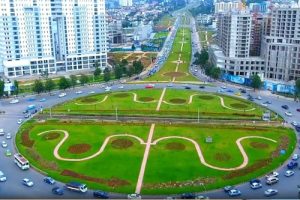
The three pillar sectors of the economy— agriculture, industry and services—play a pivotal role to achieve growth, and improve the livelihood of millions of citizens, provided that the practices are compounded with innovation.
Agriculture has provided employment opportunities to almost 80 percent of the labor force, contributes to foreign exchange earnings, and supplies food to the market at least at a subsistence level and raw materials to the manufacturing industry. The emerging manufacturing sector plays a pivotal role in creating job opportunity, attracting local and foreign investment, and boosting export as well as substituting imports. Transport, tourism, hotel and trade that fall under the service sector also play crucial role in creating job and generating income.
Solomon Zegeye is an economist and works as a consultant for various firms. This writer talked to him to get his views on the issues in question. He said currently agriculture contributes 45 percent to the nation’s Gross Domestic Product (GDP). For the two digit economic growth that was registered in the past two successive decades, the sector has played a significant role. The application of modern agricultural inputs such as fertilizer, pest and herbicides are attributable to the increment of production.
He also said that though agriculture is the mainstay of the nation’s economy, currently its contribution to the GDP is declining and this indicates that the nation is experiencing structural change and the contribution of manufacturing and service sectors to the GDP is growing.
The manufacturing and agricultural sectors feed on each other. Textile and garment, leather and shoes and agro-business are the backbone of the manufacturing sector. The textile industry essentially created job opportunity to thousands of citizens but nowadays, it is dependent on the importation of cotton. The sector supplies products mainly to the foreign markets and brings foreign currency to the national coffer.
The same goes to the leather and leather product sub sectors. The differences are the subsector gets most of the raw material supplies locally. The agro-business sub-sector also plays a key role in processing agricultural products and supplies the local market. Although it has the potential to transform the economy to a higher productivity rate, it is still at its infancy level. The sector is dependent on imported inputs such as spare partsand other shortcomings.
Currently, due to foreign currency crunch, opening letter of credit for securing currency is too much cumbersome. As a result, firms are forced to reduce their production volume.
The service sector is mostly characterized by hotels and entertainment is flourishing in the urban centers. It has created job opportunities for tens of thousands of citizens and heavily utilizes locally produced agricultural products and created link with the sector.
Tourism is one of the service sectors which play a pivotal role in job creation and foreign currency earnings.
The government is aggressively working on the expansion of lodges and parks which can attract local and foreign visitors and allocated huge amount of money for the development of tourist sites.The availing of parks and animals zoo in the city further stimulates the sector.
As to Solomon, the successive Growth and Transformation Programs were implemented before the coming to power of the current reformist government. These had their weakness because then administration had tried to implement an imported economic plan that went beyond the national context.
As a result, it was unable to achieve structural change which was targeted to be achieved by 2020 GC.
As to him, the current 10 year perspective economic development plan introduced by the current government goes inline with the reality on the ground and has a potential to attain structural change. It is prepared based on the actor institutions implementing capacity in abottom up approach.
To lay the ground for industrialization, the agriculture sector must ensure the national food self- sufficiency so that citizens productivity and creativity will be enhanced which intern drive the economy on the right track. But if it is not, the nation will continue to import food and other agricultural products using its meager resource.
To attain sustainable development, the state of the nation macro-economy should be healthy. Some of the indicators of the macro economic situation of the nation are the total employment, national fiscal policy, government revenue and expenditure. In addition money supply, interest rate and the nation foreign currency earnings capacity are the backbone of the economy.
The fiscal aspect of the nation can also be mentioned as a major indicator of the macro economic status of the country. In addition, weather the total budget of the country is covered by local sources or not; and part of it covered by foreign loan or aid determines the healthiness of the economy. And weather the nation is financing its mega projects by local sources or not defines the characteristics of the macro economy.
However, as mentioned above though agriculture is the mainstay of the national economy, it is practiced in a subsistence manner, making it vulnerable to extreme climate variation. The ever-increasing population size has also led to land fragmentation. In addition to these, as farmers lack sense of ownership of land, raising productivity is a challenge.
Asked whether there are possibilities to overcome the problems and improve farming sector, Solomon said adopting technology and utilizing more agricultural inputs can be taken as a way out.
He further said that countries which have predominantly arid areas proved the possibility of raising agricultural productivity through adopting better technology.
But as to Solomon, utilizing cutting-edge technology requires a huge amount of money which Ethiopia ill affords.
To achieve structural change,there need to be adequate planning. For instance, it behooves on policy makers to devise mechanism to shift the stranded rural labor force to urban centers. They need to be absorbed byother sectors such as manufacturing and service. Moving the labor force from farming to the non-farming activities also helps to establish extensive farm which utilizes modern farm inputs that helps raise productivity.
Currently, the cluster farming activities in rural areas have brought results in up surging productivity.
As to Solomon, in Ethiopia there is abundant natural resource which can be used as input to agriculture but due to the absence of finance, technology and skill, the nation is unable to tap the resources.
If the situation is changed for the better, the probability of ensuring food security in the future will be a low hanging fruit.
To that end, exploring and exploiting the water resources of the country is essential. The government endeavors in this regard is appreciable.
According to the report of the Ministry of Irrigation and Lowland, Ethiopia has only utilized 5 percent of its water resources for irrigation, and the arable land that can be used for extensive farming particularly found in the lowland parts of the country remained idle.
Modern irrigation farms were introduced to Ethiopia by Netherlanders in 1960s GC. Large extended farms were cultivated in the upper, middle and lower Awash River valley. Sugarcane used as input for sugar factory located in the Mattahara town which has still continued its production. In the lower Awash valley cotton plantation was cultivated and the product was supplied to local and export market but now it has ceased to exist. Large scale farms were also flourished in the north-western parts of the country in the areas of Humera and Mattama towns since 1960. The farms produced oil seeds and supply its products to local and foreign markets.
The dry season wheat irrigation farm cultivated by small-scale farmers through clustering system could bring tremendous result in meeting the local wheat demand. Some of the products also were exported to the neighboring countries and supplemented the nation’s demand for a hard currency.
Such achievement can be taken as a showcase to the nation’s capacity to ensure food security.
BY ABEBE WOLDEGIORGIS
THE ETHIOPIAN HERALD WEDNESDAY 26 JUNE 2024





